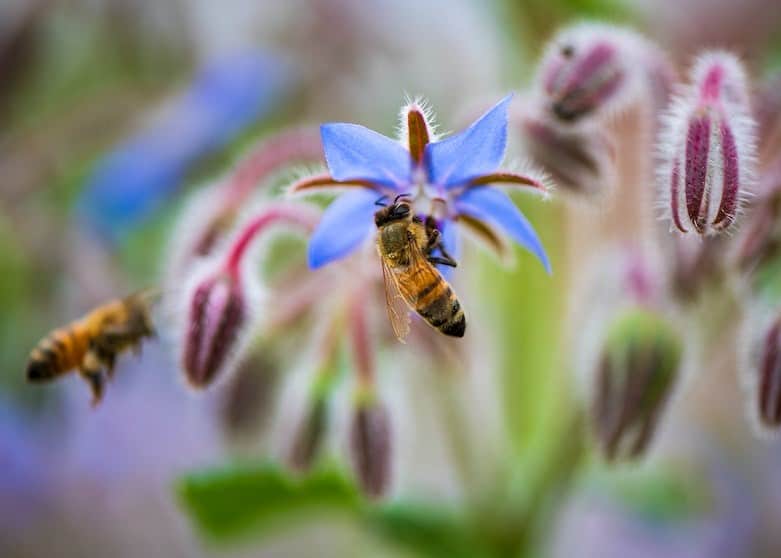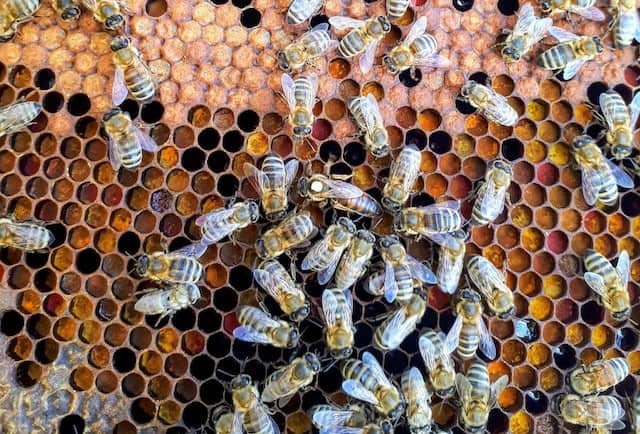One annoying habit beekeepers have is answering most questions with the same two words: It depends. The same goes for the question of how long bees live.
What type of bee are we talking about, meaning are they social bees or solitary bee species? If it is a social type of bee, what role does it play in the colony? These various factors affect how long a bee lives.
How Long Do Bees Live?
For this post, we will concentrate on the average lifespan of honeybees. But we will give some honorary mentions to a few other species you may find in your backyard.

How long does a Honey Bee live?
A honey bee colony is like the human body. Every day, cells in your body die and are disposed of, but the rest of you live on.
Different types of cells live for different lengths of time based on what they do. The same principle applies to honey bees.
The honey bee’s life span would depend on its role in the colony. Let’s look at the lifespan of our different types of honeybees.
How Long Does A Queen Bee Live?
A queen bee can live up to five years, sometimes longer. We used to think that royal jelly was the key to her long life, but studies have shown that there are other physiological factors in play.
The life span of a queen honey bee is important to the survival of the colony. Her sole responsibility is laying eggs and keeping the hive populated. Every time her daughters leave the hive, there’s no guarantee they’ll make it back. A queen bee makes sure that there’s always a backup worker available.

If she lives so long, why do beekeepers raise queen bees?
You may have heard of the term “re-queen.” This is when a beekeeper kills a colony’s queen bee and replaces her with either a new queen or provides a brood for the workers to make their queen.
As with most living creatures, the productivity of a queen bee to reproduce declines with age, at least physically. Mentally, they could be aging like fine wine, but we don’t keep queens for their conversational skills. That’s why beekeepers often re-queen after a year or two.
Sometimes, the worker bees will kill a queen if she is failing and replace her if they have the right brood.
A hobbyist probably won’t re-queen unless they want to introduce some new queens for new genes into the pool. For instance, if you have an easily irritable and aggressive colony, beekeepers are advised to re-queen to dilute those genes. With time, aggressive workers will be replaced by calmer bees.
How Long Does A Worker Bee Live?
The number one killer of worker bees is probably fatigue. They work themselves to death. When there’s more work to do, workers have a very short life expectancy.
During the active season (spring and summer months), there’s a lot of foraging, brood caring to get done, and honey production. The worker bees are very busy. During this time, worker honey bees live about 6-7 weeks.
As the bees prepare for winter, the level of activity reduces. The queens stopped laying eggs to reduce the resources needed to get the colonies through the cold season. The foraging activity grinds to a halt, and the purpose of the worker bees is to keep themselves and the queen warm enough to survive the winter.
The worker honey bees live about 4-6 months since there’s no brood to replace them during the winter period.
Aside from predators, pests and diseases can reduce the lifespan of worker honey bees. A mite infestation, for instance, can weaken the immune system of a bee, making them susceptible to other diseases.
Pesticide poisoning can also cause mass fatalities or slowly alter bee behavior to the point of death. Some pesticides affect the bees’ ability to remember the way back to the hive. Without the warmth of its siblings, a bee is unlikely to survive the night.

How Long Does A Drone Bee Live?
There’s something to be said about dying when you know you have achieved your life’s purpose. For drone bees, that’s their story.
In the case of a healthy drone honey bee, it could make it for about two months. Alternatively, it could meet a queen, mate, and die much sooner.
Aside from predation, diseases can also affect their lifespan. The Deformed Wing Virus, which is spread by Varroa mites, can cause, as the name suggests, deformed wings. With deformed wings, they can’t fly. Since a mating flight is a mile-high sort of club, male drones can’t mate and, hence, eventually die a purposeless life.
They are also kicked out of the hive by worker bees when food is tight. That can be in the summer during a nectar dearth or in preparation for winter. Drones are an investment the colony makes when there’s enough nectar flow or food to go around. Since drones don’t forage nor care for brood, they offer no benefit to the hive and are evicted as free-loaders.
How Long Does the Bee Colony Live?

The entire colony, like the body, can outlive every individual member of the colony.
When spring comes around, there’s a swarming season. This is when the colony “gives birth” to a new colony.
It happens when the existing old queen takes some of the workers with her and flies off to set up a nest elsewhere.
She leaves behind a virgin queen to take her place. This life cycle can continue for years, meaning you can have a colony in the same hive for decades.
How Long Do Other Bees Live?
Bumblebees
Just like honeybees, bumblebees are social insects and live in colonies for a portion of their lives. For these fuzzy bees, the length of their lifespan depends on their role in the hive.
Queen Bumblebees
Bumblebee queens live about one year. She starts off by mating and then hibernating, so her active period is a few months between spring and fall.
Worker Bumblebees
Bumblebee workers live for about 2-6 weeks, depending on the assigned tasks. The foragers have a lot more to worry about, so they live a shorter, busier life than their in-hive care counterparts.

Drones
These typically live for about 2 weeks. This gives them enough time to fly as far away from their nest as possible so they can avoid inbreeding.
Carpenter Bees
Even though they exhibit some social behavior by sharing the same cavities, they are solitary bees.
Female Carpenter Bees
Females can live at least one year, maybe more. They emerge in late summer and build up stores by feeding on pollen and nectar so that they can hibernate over the winter.
In the spring, they wake up, mate, lay eggs, and pad the little cell with pollen to get the emerging larvae ready for adulthood.
Male Carpenter Bees
The males start like females, emerging in the summer, feeding, and hibernating. They wake up before the females and aggressively hover over nests to get a mate.
Once they mate, they die soon after that and probably won’t make it a year.
Do you have any other questions about beekeeping? Let us know in the comment section below.

Even though I’m not really a bee’keeper’ per se, I do know RQR is real. ReQueen Regret. Awareness is key here.
Rumor has it, sometimes the queens get tired of waiting and are left with no choice but to just crown a new queen, to prove a point. That brings me back to awareness, of being oh so close to having that queen and then she reroutes. It is very sad, for all parties involved. Nonetheless.